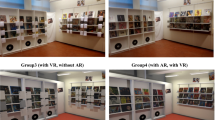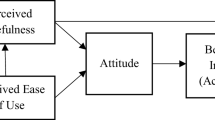Abstract
A special strain of situational impairment, termed “Severely Constraining Situational Impairments” (SCSI), was explored from a novel qualitative perspective. When a severely impairing event presents, the multitude and complexity of ambient agents are often overwhelming, leading to the inability to devise a solution. To classify and help design for them, interviews and participatory design-based workshops were conducted, revealing that (1) participants attempt to complete mobile transactions, even if it might place them in considerable danger, and (2) significant differences exist in the modalities and steps used to address the onset of a severely impairing event versus those of a non-severe situational impairment. Design solutions generated from the workshops indicated that users want technology to take a larger role in helping manage the added cognitive load inherent in severely impairing events. The revealed implications for design indicate that to maximize the user experience in the mobile device transaction space, designers must account for the presence of these SCSI and the unique design specifications that they require.

Similar content being viewed by others
References
Barnard, L., Yi, J., Jacko, J.A., Sears, A.: Capturing the effects of context on human performance in mobile computing systems. Pers. Ubiquit. Comput. 11(2), 81–96 (2007). https://doi.org/10.1007/s00779-006-0063-x
Bødker, S.: A human activity approach to user interface. Hum. Computer Interact. 4(3), 171–195 (1989). https://doi.org/10.1207/s15327051hci0403_1
Contact Vibrate (n.d.) (2018). https://play.google.com/store/apps/details?id=ac.vibration&hl=en_US
Gheran, B.-F., Vanderdonckt, J., Vatavu, R.-D.: Gestures for smart rings: empirical results, insights, and design implications. In: Proceedings of the 2018 Designing Interactive Systems Conference, pp. 623–635 (2018). https://doi.org/10.1145/3196709.3196741
Goel, M., Findlater, L., Wobbrock, J.: Walktype: using accelerometer data to accommodate situational impairments in mobile touch screen text entry. In: Proceedings of the SIGCHI Conference on Human Factors in Computing Systems, pp. 2687–2696. ACM, Austin, Texas USA (2012). https://doi.org/10.1145/2207676.2208662
Hollan, J., Stornetta, S.: Beyond being there. In: Proceedings of the SIGCHI Conference on Human Factors in Computing Systems, pp. 119–125. ACM, New York, NY, USA (1992). https://doi.org/10.1145/142750.142769
Jain, V., Hebbalaguppe, R.: Airpen: a touchless fingertip based gestural interface for smartphones. In: CHI’19 Workshop: Addressing the Challenges of Situationally-Induced Impairments and Disabilities in Mobile Interaction. (2019) Retrieved from Arxiv: https://arxiv.org/abs/1904.06122
Jarl, G., Lundqvist, L.-O.: An alternative perspective on assistive technology: the person–environment–tool (pet) model. Assist. Technol. (2018). https://doi.org/10.1080/10400435.2018.1467514
Kane, S.K., Wobbrock, J.O., Smith, I.E.: Getting off the treadmill: evaluating walking user interfaces for mobile devices in public spaces. In: Proceedings of the 10th International Conference on Human Computer Interaction with Mobile Devices and Services, pp. 109–118. ACM, New York, NY, USA (2008). https://doi.org/10.1145/1409240.1409253
Kuber, R., Yu, W., McAllister, G.: Towards developing assistive haptic feedback for visually impaired internet users. In: Proceedings of the SIGCHI conference on Human Factors in Computing Systems, pp. 1525–1534 (2007). https://doi.org/10.1145/1240624.1240854
Laubheimer, P.: Distracted driving: UX’s responsibility to do no harm (2018). Retrieved from Nielsen Norman Group: https://www.nngroup.com/articles/distracted-driving-ux/. Retrieved 6 Nov 2019
Lee, S., Cha, M., Hwangbo, H., Mo, S., Ji, Y.: Smartphone form factors: effects of width and bottom bezel on touch performance, workload, and physical demand. Appl. Ergon. 67, 142–150 (2018). https://doi.org/10.1016/j.apergo.2017.10.002
Lin, M., Goldman, R., Price, K.J., Sears, A., Jacko, J.: How do people tap when walking? an empirical investigation of nomadic data entry. Int. J. Hum. Computer Stud. 65(9), 759–769 (2007). https://doi.org/10.1016/j.ijhcs.2007.04.001
Marshall, J., Tennent, P.: Mobile interaction does not exist. In: CHI ‘13 Extended Abstracts on Human Factors in Computing Systems, pp. 2069–2078. Paris, France (2013). https://doi.org/10.1145/2468356.2468725
Moser, C., Schoenebeck, S.Y., Reinecke, K.: Technology at the table: attitudes about mobile phone use at mealtimes. In: Proceedings of the 2016 CHI Conference on Human Factors in Computing Systems, pp. 1881–1892. ACM, New York, NY, USA (2016). https://doi.org/10.1145/2858036.2858357
National Center for Statistics and Analysis: Distracted driving 2015. In: Traffic Safety Research Notes. DOT HS 812 381 (2017). Retrieved from National Highway Traffic Administration: https://crashstats.nhtsa.dot.gov/Api/Public/ViewPublication/812381. Retrieved 6 Nov 2019
National Highway and Traffic Safety Administration. In: Overview of the National Highway Traffic Safety Administration’s Distracted Driving Research Plan (DOT HS 811 299) (2010). Retrieved from National Highway Traffic Administration: https://one.nhtsa.gov/Research/Human-Factors/Distraction. Retrieved 6 Nov 2019
Neerincx, M.A., Cremers, A.H., Kessens, J.M., van Leeuwen, D.A., Truong, K.P.: Attuning speech-enabled interfaces to user and context for inclusive design: technology, methodology and practice. Univ. Access Inf. Soc. 8(2), 109–122 (2009). https://doi.org/10.1007/s10209-008-0136-x
Nicolau, H.: Disabled ‘R’ all: bridging the gap between health and situational induced impairments and disabilities. ACM SIGACCESS Access. Comput. 1(102), 21–24 (2012). https://doi.org/10.1145/2140446.2140451
Ogonowski, C., Ley, B., Hess, J., Wan, L., Wulf, V.: Designing for the living room: long-term user involvement in a living lab. In: Proceedings of the SIGCHI Conference on Human Factors in Computing Systems, pp. 1539–1548 (2013). https://doi.org/10.1145/2470654.2466205
Prensky, M.: Digital natives, digital immigrants part 1. On Horiz. 9(5), 1–6 (2001). https://doi.org/10.1108/10748120110424816
Quinde, M., Khan, N., Augusto, J., van Wyk, A., Stewart, J.: Context-aware solutions for asthma condition management: a survey. Univ. Access Inf. Soc. (2018). https://doi.org/10.1007/s10209-018-0641-5
Sarsenbayeva, Z., Goncalves, J., Garcia, J., Klakegg, S., Rissanen, S., Rintamäki, H., Hannu, J., Kostakos, V.: Situational impairments to mobile interaction in cold environments. In: Proceedings of the 2016 ACM International Joint Conference on Pervasive and Ubiquitous Computing (UbiComp ‘16), pp. 85–96. Heidelberg, Germany (2016). https://doi.org/10.1145/2971648.2971734
Sarsenbayeva, Z., van Berkel, N., Hettiachchi, D., Jiang, W., Dingler, T., Velloso, E., Kostakos, V., Goncalves, J.: Measuring the effects of stress on mobile interaction. Proc. ACM Interact. Mob. Wearable Ubiquit. Technol. 3(1), Article 24 (2019). https://doi.org/10.1145/3314411
Sarsenbayeva, Z., van Berkel, N., Luo, C., Kostakos, V., Goncalves, J: Challenges of Situational Impairments during Interaction with Mobile Devices. In: OZCHI ‘17: Proceedings of the 29th Australian Conference on Computer-Human Interaction, pp. 477–481. Brisbane, QLD Australia (2017). https://doi.org/10.1145/3152771.3156161
Sarsenbayeva, Z., van Berkel, N., Velloso, E., Kostakos, V., Goncalves, J: Effect of distinct ambient noise types on mobile interaction. In: Proceedings of the ACM on Interactive, Mobile, Wearable and Ubiquitous Technologies, 2(2), Article 82 (2018). https://doi.org/10.1145/3214285
Saulynas, S., Burgee, L.E., Kuber, R,: All Situational impairments are not created equal: a classification system for situational impairment events and the unique nature of severely constraining situational impairments. In: iConference. Wuhan, China (2017). https://doi.org/10.9776/17015
Sears, A., Lin, M., Jacko, J., Xiao, Y.: When computers fade: pervasive computing and situationally-induced impairments and disabilities. HCI Int. 2(3), 1298–1302 (2003)
Shreepriya, S., Gallo, D., Viswanathan, S., Willamowski, J.: Situationally induced impairment in navigation support for runners. In: CHI’19 Workshop: Addressing the Challenges of Situationally-Induced Impairments and Disabilities in Mobile Interaction (2019). Retrieved from Arxiv: https://arxiv.org/abs/1904.06131
Tigwell, G.W., Flatla, D.R., Menzies, R.: It’s not just the light: understanding the factors causing situational visual impairments during mobile interaction. In: Proceedings of the 10th Nordic Conference on Human-Computer Interaction (NordCHI ‘18), pp. 388–351. ACM, Oslo, Norway (2018) https://doi.org/10.1145/3240167.3240207
Tung, Y.-C., Goel, M., Zinda, I., Wobbrock, J.O.: Raincheck: overcoming capacitive interference caused by rainwater on smartphones. In: Proceedings of the 2018 on International Conference on Multimodal Interaction (ICMI ‘18), pp. 464–471. Boulder, CO, USA (2018). https://doi.org/10.1145/3242969.3243028
Wobbrock, J.O.: The future of mobile device research in HCI. In: CHI 2006 Workshop Proceedings: What is the Next Generation of Human-Computer Interaction, 131–134 (2006)
Wobbrock, J.O.: Situationally-induced impairments and disabilities. In: Yesilada, Y., Harper, S. (eds.) Web Accessibility: A Foundation for Research, 2nd edn, pp. 59–92. Springer, London (2019)
Wolf, F., Kuber, R.: Developing a head-mounted tactile prototype to support situational awareness. Int. J. Hum. Computer Stud. 109, 54–67 (2018). https://doi.org/10.1016/j.ijhcs.2017.08.002
Acknowledgements
The authors wish to acknowledge the assistance of Lawrence Burgee, Ph.D., and Robert H. Cormier, Jr., B.A., for their input to this work.
Author information
Authors and Affiliations
Corresponding author
Ethics declarations
Conflict of interest
The authors declare that they have no conflict of interest.
Additional information
Publisher's Note
Springer Nature remains neutral with regard to jurisdictional claims in published maps and institutional affiliations.
Rights and permissions
About this article
Cite this article
Saulynas, S., Kuber, R. Understanding and supporting individuals experiencing severely constraining situational impairments. Univ Access Inf Soc 19, 919–933 (2020). https://doi.org/10.1007/s10209-019-00705-7
Published:
Issue Date:
DOI: https://doi.org/10.1007/s10209-019-00705-7




